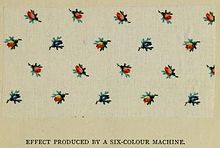Calico

Calico (/ˈkælɪkoʊ/; in British usage since 1505)[1] is a heavy[2] plain-woven textile made from unbleached, and often not fully processed, cotton. It may also contain unseparated husk parts. The fabric is far coarser than muslin, but less coarse and thick than canvas or denim. However, it is still very cheap owing to its unfinished and undyed appearance.
The fabric was originally from the city of
History
Origins
Calico originated in
Politics of cotton in the British Empire
In the 18th century, England was famous for its
In 1764, 1,755,580 kg (3,870,392 lb) of cottonwool was imported.[7] This change in consumption patterns, as a result of the restriction on imported finished goods, was a key part of the process that reduced the Indian economy from sophisticated textile production to the mere supply of raw materials. These events occurred under colonial rule, which started after 1757, and were described by Nehru and also some more recent scholars as "de-industrialization".[8]
Calico printing

Early Indian chintz, that is, glazed calico with a large floral pattern, was primarily produced using painting techniques.[9] Later, the hues were applied by wooden blocks, and the cloth manufacturers in Britain printed calico using wooden block printing. Calico printers at work are depicted in one of the stained glass windows made by Stephen Adam for the Maryhill Burgh Halls, Glasgow.[10] Confusingly, linen and silk printed this way were known as linen calicoes and silk calicoes. Early European calicoes (1680) were cheap plain weave white cotton fabric, or cream or unbleached cotton, with a design block-printed using a single alizarin dye fixed with two mordants, giving a red and black pattern. Polychromatic prints were possible, using two sets of blocks and an additional blue dye. The Indian taste was for dark printed backgrounds, while the European market preferred a pattern on a cream base. As the century progressed the European preference moved from the large chintz patterns to smaller, tighter patterns.[11]
The trade association remained in operation until 1954, when the arrangement was challenged by the government
Terminology

In the UK, Australia and New Zealand:
- Calico – simple, cheap equal weft and warp plain weave fabric in white, cream or unbleached cotton
- Calico bag - a bag made of calico used by banks and other financial institutions
- Muslin – a very fine, light plain weave cotton fabric
- Muslin gauze – US: muslin – simple, cheap equal weft and warp plain weave fabric in white, cream or unbleached cotton and/or a very fine, light plain weave cotton fabric
- Gauze – extremely soft and fine cotton fabric with a very open plain weave
- Cheesecloth – US: gauze – any very light fabric, generally with a plain weave
- Tote Bag - sometimes made of calico
In the US:
- Calico – cotton fabric with a small, all-over floral print[15]
- Muslin – UK: muslin gauze – simple, cheap equal weft and warp plain weave fabric in white, cream or unbleached cotton and/or a very fine, light plain weave cotton fabric
- Muslin gauze – the very lightest, most open weave of muslin
- Gauze – UK: cheesecloth – any very light fabric, generally with a plain weave
- Cheesecloth – extremely soft and fine cotton fabric with a very open plain weave
Printed calico was imported into the United States from Lancashire in the 1780s, and here a linguistic separation occurred. While Europe maintained the word calico for the fabric, in the States it was used to refer to the printed design.[11]
These colourful, small-patterned printed fabrics gave rise to the use of the word calico to describe a cat coat colour: calico cat. The patterned fabric also gave its name to two species of North American crabs; see Ovalipes ocellatus.[11]
See also
References
- ISBN 9780191623172. Retrieved 16 January 2014.
- ^ Oxford Advanced Learner's Dictionary of Current English ISBN 019 431 5339, 2000, page 166
- ^ a b c d Encyclopædia Britannica (2008). "calico".
- ISBN 9780313336652.
- ^ a b Espinasse 1874, p. 296
- ^ Espinasse 1874, p. 298
- ^ Espinasse 1874, p. 299
- doi:10.3386/w10586.
- ^ a b Turnbull, A History of Calico Printing in Great Britain, 1951.
- ^ "Maryhill Burgh Halls: Historic Stained Glass". Maryhill Burgh Halls. 18 March 2019. Retrieved 27 August 2022.
- ^ a b c "You searched for calico, Muslin, gauze".
- ^ Glover, Stephen (1831). The history and gazetteer of the county of Derby. p. 216. Retrieved 26 November 2009.
- ^ "Calico Printers Association - Graces Guide". www.gracesguide.co.uk.
- ^ Hughes, William (13 April 1954). Report on the Process of Calico Printing. House of Commons, London: Monopolies and Restrictive Practices Commission. Archived from the original on 21 January 2012. Retrieved 8 December 2010.
- ISBN 0-13-118769-4
External links
- Espinasse, Francis (1874). Lancashire Worthies. London: Simpkin, Marshall, & Co. Retrieved 1 December 2010.
- Beach, Chandler B., ed. (1914). . . Chicago: F. E. Compton and Co.
- Charles O'Neill (1869) A dictionary of dyeing and calico printing – digital facsimile from the Linda Hall Library
- William Crookes (1874) A practical handbook of dyeing and calico-printing. Illustrated with period fabric swatches. – digital facsimile from the Linda Hall Library
- Baba Gee Calico Printing A calico Printing store Archived 16 September 2021 at the Wayback Machine. where design fabric with calico technique.
- Deazley, R. (2008) 'Commentary on the Calico Printers' Act 1787', in Primary Sources on Copyright (1450–1900), eds L. Bently & M. Kretschmer,Copyright History 1787 Calico Printers' Act
